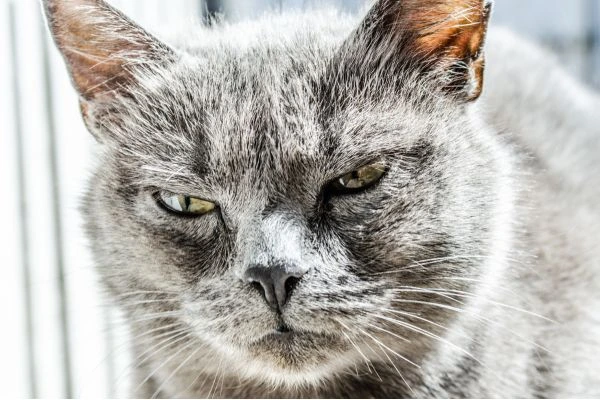Cats are extremely subtle creatures.
They aren’t that expressive.
If you had looked closely, you would’ve seen that they always have a passive expression.
Hence, sometimes it becomes difficult for pet owners to understand them.
Thus, we bring to you a well-researched article on the signs of an unhappy cat and how to deal with it.
1. Sudden Aggression or Irritability
If your usually calm cat suddenly hisses, swats, or bites, it’s a clear red flag. Aggression is often a cat’s way of expressing discomfort, fear, or pain. Unhappy cats may lash out unexpectedly—even at familiar people or pets.
It’s important to note the context: are they guarding a space, reacting to touch, or responding to a change in routine? Cats who feel trapped, stressed, or threatened often become reactive. Irritability can also stem from boredom or lack of stimulation.
Pay attention to their body language—puffed-up fur, twitching tails, and pinned ears mean “back off.” Never punish the behavior; instead, look for the root cause. Addressing their stress source is the first step to healing their mood.
2. Hiding More Than Usual
While cats enjoy privacy, excessive hiding can signal distress. If your cat is constantly under the bed, in closets, or avoiding contact altogether, it might be more than shyness. Cats often hide when they’re scared, anxious, or feeling unwell.
This is especially concerning if the behavior is new or sudden. Watch their routines: are they skipping meals or avoiding their favorite resting spots? Changes in the household—like new people, pets, or loud noises—can trigger hiding.
Illnesses also make cats withdraw, as it’s instinctual to seek safety when vulnerable. Monitor the duration and severity of this behavior. A hiding cat is often a hurting cat—emotionally or physically.
See Also:
3. Change in Eating Habits
Cats are creatures of routine, especially when it comes to food. A sudden lack of appetite, overeating, or eating too quickly may signal something’s wrong. Unhappy or depressed cats may skip meals entirely or become disinterested in treats they once loved.
On the flip side, some cats stress-eat or constantly beg for food as a coping mechanism. This shift could point to emotional problems or health issues like dental pain, nausea, or thyroid problems.
Monitor changes closely—especially if they last longer than a day. Unexplained weight loss or gain is a major red flag. Don’t ignore food dish signals—they say a lot about your cat’s emotional state.
4. Excessive Meowing or Unusual Vocalizations
While some cats are naturally talkative, increased or unusual meowing can mean distress. If your quiet cat suddenly becomes loud or your vocal cat changes tone, pay attention.
These vocalizations may reflect loneliness, anxiety, or physical discomfort. You might notice constant pacing paired with whining or yowling. Some cats cry at doors, windows, or in the middle of the night—indicating confusion or frustration.
Always listen for changes in pitch or intensity. A distressed cat may sound hoarse or desperate. This behavior is their way of saying, “Something’s not right.” Listen closely—their voice is often their cry for help.
5. Over-Grooming or Lack of Grooming
Grooming habits reflect a cat’s well-being. Unhappy cats may stop grooming altogether, leading to a greasy, unkempt coat. Others may do the opposite—obsessively licking, chewing, or pulling out fur.
Over-grooming often creates bald patches or skin irritation and can be triggered by stress, anxiety, or boredom. Cats under emotional strain may fixate on grooming as a coping behavior.
Alternatively, neglecting their fur could signal depression or illness. Watch for excessive shedding or raw spots on their belly, thighs, or sides. A change in grooming habits is always a cause for concern. Their fur reflects their inner feelings.
6. Litter Box Issues
When a cat stops using the litter box, it’s not just bad manners—it’s a message. Peeing or pooping outside the box can signal emotional upset, territorial stress, or medical problems. Cats may avoid the box if it’s dirty, in a loud area, or associated with fear.
Stress from a new pet, household move, or schedule change can cause litter box aversion. Marking with urine is often territorial, especially in multi-cat homes.
Consistency in box location and cleanliness is crucial. If your cat suddenly starts having accidents, it’s time to investigate deeper. Never punish them—try to uncover what’s making them uncomfortable or anxious.
7. Destructive Behavior
Scratching furniture, knocking things over, or digging into trash could be signs of a stressed or unhappy cat. While some mischief is normal, sudden or repetitive destruction often means they’re acting out.
Cats need physical and mental stimulation—without it, frustration builds up. Changes in the home, lack of playtime, or separation anxiety can lead to these outbursts. Scratching is a natural stress reliever for cats and shouldn’t be punished.
Instead, redirect it with scratch posts or interactive toys. Destructive behavior is communication—not defiance. Your cat may be saying, “I’m bored, lonely, or frustrated.”
8. Lethargy or Low Energy
An unhappy cat may lose interest in playtime, toys, and even human interaction. They may seem uninterested in things they once enjoyed and spend excessive time sleeping or lying around.
While cats do nap a lot, unusual sluggishness or disinterest could signal emotional or physical issues. Watch if they stop running to the window, chasing toys, or greeting you.
Depression and illness often appear similar in cats, so it’s essential to monitor their activity levels. If they’re not even responding to favorite treats or sounds, it’s a red flag.
Lethargy is a sign they’re shutting down emotionally or unwell physically. A content cat is curious—a withdrawn one needs support.
How to Handle an Unhappy Cat
- Give Them Space and Security: When a cat is upset or stressed, forcing interaction can make things worse. Offer quiet, comfortable hiding spots where they can retreat and feel safe.
- Provide Mental and Physical Stimulation: Boredom is a common cause of feline unhappiness. Introduce interactive toys, puzzle feeders, climbing trees, and window perches to enrich their day.
- Maintain a Predictable Routine: Cats thrive on consistency. Try to feed, play with, and clean their litter boxes at the same time every day. Sudden changes in routine can increase anxiety, especially in sensitive cats. A predictable environment helps them feel secure and in control.
- Address Litter Box Issues Promptly: Inappropriate elimination can be a cry for help. Ensure the litter box is clean, placed in a quiet area, and is easily accessible. Avoid scented litters or covered boxes if your cat seems reluctant to use them.
- Use Calming Aids if Needed: If your cat continues to show signs of stress, consider using calming aids like pheromone diffusers (e.g., Feliway), calming collars, or treats with natural relaxants. These can help reduce anxiety in tense situations like moving or new pet introductions.
- Seek Veterinary or Behavioral Help: If behavioral changes last longer than a few days or worsen, it’s essential to consult a vet. Medical issues like pain, hyperthyroidism, or dental disease can mimic unhappiness.
When to Consult a Vet
If your cat’s behavior suddenly changes without any obvious cause, it’s time to consult a veterinarian. Sudden withdrawal, aggression, or loss of appetite can be signs of underlying health problems such as infections, dental pain, or arthritis. Cats are experts at hiding discomfort, so even subtle changes should be taken seriously.
Prolonged lethargy, vomiting, diarrhea, or changes in litter box habits should never be ignored. These physical symptoms often accompany emotional distress but may point to medical conditions that require prompt treatment. A vet can perform a full health check to rule out or address any physical causes.
Excessive grooming or fur loss can be more than just a behavioral issue. Skin infections, parasites, or allergies might be to blame. A professional evaluation will help determine if the problem is medical or stress-related and guide the appropriate treatment or management.
Additionally, if your cat’s unhappiness persists despite environmental improvements, enrichment, and affection, a vet can refer you to a feline behaviorist.
Early intervention can prevent a mild issue from developing into a chronic behavioral disorder, ensuring your cat returns to a happy and healthy state.
Veterinary care is crucial for ruling out medical causes like infections, arthritis, hyperthyroidism, or depression. It’s always better to be safe than sorry—cats are experts at hiding illness.
While cats have the same passive facial expressions, their behavior can speak loads.
It is very crucial that you understand their calls and behavior.
A healthy cat is a happy cat!!

Nikita Rout is a passionate content writer at HowItSee.com, where she explores the wonders of animals, nature, and the curious questions that spark our imagination. With a love for research and a knack for simplifying complex topics, she brings clarity and creativity to every article she writes. When she’s not writing, you’ll likely find her reading about animal behavior or coming up with unique pet name ideas.

